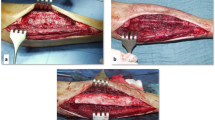Abstract
A Tissue Bank is a valuable adjunct to tumour management. In bone tumours, the defects produced by ablative surgery can be reconstructed using banked tissue, thereby obviating the donor site morbidity associated with autografts. Allografts are especially useful in large defects or in children where the quantity of available autograft is limited. The use of bone allografts in India has been limited by the availability of good quality, affordable grafts. In this article we share our experience with the use of indigenously produced allografts in limb salvage, as bone graft expanders and as struts. Lyophilised, irradiated bone allografts were morcellised and used in 32 patients. In 21 of these patients the allograft was used in contained cavities. Complete incorporation of the graft was seen between 6–9 months in all the 25 cases available for follow-up. In 4 patients the allograft was layered onto autograft. The allograft incorporated with the host bone in only one of these patients.
Struts were used in 9 cases (3 cases complete intercalary segmental defect, 3 cases of hemicortical defects, 2 cases of allograft-prosthesis composite around the hip, 1 case an iliac-crest block was used to stop bleeding from an anterior sacral defect). Of these, no incorporation of the full segment struts was observed in 2 patients who were on chemotherapy and radiotherapy. The sacral defect case was lost to follow-up. All the other struts incorporated with the host bone within 6–9 months. In 5 cases there was sterile postoperative drainage. Overall infection was observed in 4 patients (10%). In one the graft was removed, another settled uneventfully with subsequent incorporation of graft, and two have a persisting sinus but good incorporation. Since radiation and lyophilisation are known to affect the material properties of bone, the grafts were rehydrated in saline for 30 minutes prior to transplantation. Autogenous marrow or autograft was used to provide osteoinductive properties. In selected cases the lyophilised, irradiated bone allografts proved to be clinically useful in the reconstruction of large tumour defects.
Similar content being viewed by others
References
Banwart JC, Asher MA and Hassanein RS Iliac crest bone graft harvest donor site morbidity. Spine 20(9): 1055-6
Boyce T, Edwards J and Scarborough N (1999) Allograft Bone. The influence of processing on safety and performance. Orthop Clin North Am 30(4): 571-581
Cockin J (1971) Autologous bone grafting: Complications at the donor site. J Bone Joint Surg Br 53-B: 153
Conrad EU, Ericksen DP, Tencer A et al. (1993) The effects of rehydration on cancellous bone. Clin Orthop 290: 279-284
Dick HM, Malinin TI and Mnaymneh W (1985) Massive allograft implantation following radical resection of high-grade tumors requiring adjuvant chemotherapy treatment. Clin Orthop 198: 88
Fernyhough JC, Schimandle JJ,Weigel MC et al. Chronic donor site pain complicating bone graft harvesting from posterior iliac crest for spinal fusion. Spine 17(210): 1470-8
Gazdag AR, Lane JM, Glaser D and Forster RA (1995) Alternatives to autogenous bone graft: efficacy and indications. J Am Acad Orthop Surg 3(1): 1-8
Kreibich DN, Scott IR, Wells JM and Saleh M (1994). Donor site morbidity at iliac crest: Comparison of percutaneous and open methods. J Bone Joint Surg 76(B) (5)
Laurie SWS, Kaban LB, Mulliken JB and Murray JE (1984). Donorsite morbidity after harvesting rib and iliac bone. Plast Reconstr Surg 73: 933-8
Lim EV, Lavadia WT and Roberts JM (1996) Superior gluteal artery injury during iliac bone grafting for spinal fusion. A case report and literature review. Spine 21(20): 2376-8
Lobo Gajiwala A (2002) Tissue Banking in India: Gamma irradiated allografts. Cell Tissue Bank (this issue)
Sim FH and Frassica FJ (1993). The use of allografts following resection of tumors of the musculoskeletal system. Instr Course Lect 42: 405-413
Summers BN and Eisenstein SM (1989) Donor site pain from the ilium: A complication of lumbar spine fusion. J Bone Joint Surg Br 71-B: 677-80
Yousof N (1994) The use of gamma irradiation for sterilisation of bones and amnion. Mal J Nuc Sci 12(1): 243-251
Yousof N (1999) Quality System for the Radiation Sterilisation of Tissue Grafts. Phillips GO, Strong DM, von Versen R and Nath (eds) Advances in Tissue Banking, Vol. 3
Author information
Authors and Affiliations
Corresponding author
Rights and permissions
About this article
Cite this article
Lobo Gajiwala, A., Agarwal, M., Puri, A. et al. The Use of Irradiated Allografts in Reconstruction of Tumor Defects – the Tata Memorial Hospital Experience. Cell Tissue Banking 4, 125–132 (2003). https://doi.org/10.1023/B:CATB.0000007025.14614.42
Issue Date:
DOI: https://doi.org/10.1023/B:CATB.0000007025.14614.42




